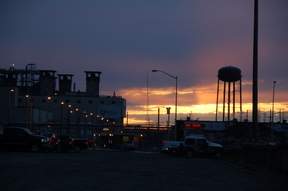
 Naturally, surrounded as I was by Winnipeg Blue Bombers fans in Thompson, Manitoba yesterday, and my contrarian chosen Hamilton Tiger-Cats already sadly declawed early in the second quarter, before a national television audience no less, the conversation turned to Ethiopian lakes and nearby locales that hold no life. OK, the analogy may not be quite perfect but close enough, and what else is one to do in a roomful of Westerners who think of places like Toronto and Hamilton as “down east”?
Naturally, surrounded as I was by Winnipeg Blue Bombers fans in Thompson, Manitoba yesterday, and my contrarian chosen Hamilton Tiger-Cats already sadly declawed early in the second quarter, before a national television audience no less, the conversation turned to Ethiopian lakes and nearby locales that hold no life. OK, the analogy may not be quite perfect but close enough, and what else is one to do in a roomful of Westerners who think of places like Toronto and Hamilton as “down east”?
Turns out, while the Dallol crater and its so-called Black and Yellow lakes, located in the Ethiopian Danakil Depression, may not support life, other parts of the larger Danakil do. Or not. Take note Ticats fans.
The Danakil Depression is located more than 100 metres below sea level in a volcanic area in northwest Ethiopia, close to the border with Eritrea, aptly named “Afar.” It is part of the East African Rift System, a place where the Earth’s internal forces are currently tearing apart three continental plates, creating new land, and it is arguably the hottest place on the planet, and one of the driest. Researchers in the field contend with sweltering heat, toxic hydrogen sulphide gas, and chlorine vapour that will burn their airways and choke their lungs without gas masks.
Picking up an article from the Madrid-based Spanish Foundation for Science and Technology, the London-based Institute of Physics (IOP) on its physics.org website reported Nov. 22 that “Scientists find a place on Earth where there is no life.” The lede notes: “Living beings, especially micro-organisms, have a surprising ability to adapt to the most extreme environments on Earth, but there are still places where they cannot live. European researchers have confirmed the absence of microbial life in hot, saline, hyper-acid ponds in the Dallol geothermal field in Ethiopia.”
The article goes on to explain the “infernal landscape of Dallol, located in the Ethiopian depression of Danakil, extends over a volcanic crater full of salt, where toxic gases emanate and water boils in the midst of intense hydro-thermal activity. It is one of the most torrid environments on Earth. There, daily temperatures in winter can exceed 45 degrees Celsius and there are abundant hyper-saline and hyper-acid pools with pH values that are even negative” (https://phys.org/news/2019-11-scientists-earth-life.html).
“A recent study, published this year, reports that certain micro-organisms can develop in this multi-extreme environment (simultaneously very hot, saline and acid), which has led its authors to present this place as an example of the limits that life can support, and even to propose it as a terrestrial analogue of early Mars.
“However, a French-Spanish team of scientists led by biologist Purificación Lopez Garcia of the French National Centre for Scientific Research (CNRS) has now published an article in Nature Ecology & Evolution that concludes otherwise. According to these researchers, there is no life in Dallol’s multi-extreme ponds.”
Lopez Garcia says, “After analyzing many more samples than in previous works, with adequate controls so as not to contaminate them and a well-calibrated methodology, we have verified that there’s no microbial life in these salty, hot and hyper-acid pools or in the adjacent magnesium-rich brine lakes. What does exist is a great diversity of halophilic archaea (a type of primitive salt-loving micro-organism) in the desert and the saline canyons around the hydro-thermal site, but neither is found in the hyper-acid and hyper-saline pools themselves, nor in the so-called Black and Yellow lakes of Dallol, where magnesium abounds. And all this despite the fact that microbial dispersion in this area, due to the wind and to human visitors, is in Thermaltense.”
Jasmin Fox-Skelly, a freelance science writer based in Cardiff, took a somewhat more upbeat approach a couple of years ago, but one based on older data, in her Aug. 4, 2017 piece “In Earth’s hottest place, life has been found in pure acid,” for BBC Future, which describes it website as “something different” in “a complex, fast-paced world of soundbites, knee-jerk opinions and information overload.” BBC Future says it provides a “home for slowing down, delving deep and shifting perspectives” on “almost every topic that matters.”
“In a surreal landscape of colours, dominated by luminescent ponds of yellows and greens, boiling hot water bubbles up like a cauldron, whilst poisonous chlorine and sulphur gases choke the air,” Fox-Skelly’s story opens. “Known as the ‘gateway to hell’, the Danakil Depression in Ethiopia is scorchingly hot and one of the most alien places on Earth. Yet a recent expedition to the region has found it is teeming with life” (https://www.bbc.com/future/article/20170803-in-earths-hottest-place-life-has-been-found-in-pure-acid).
Fox-Skelly reported that Barbara Cavalazzi from the University of Bologna in Italy, part of a team conducting scientific expeditions in the area since 2013, found life in the Danakil Depression in March 2017, “after they managed to isolate and extract DNA from bacteria. They found that the bacteria are ‘polyextremophiles,” which means they are adapted to extreme acidity, high temperatures and high salinity all at once. It is the first absolute confirmation of microbial life in the Danakil acidic pools.”
So Spanish research? French research? Or Italian research? Life or no life (or some life) in the Danakil Depression?
You know, the sort of questions Hamilton Tiger-Cats fans were asking in their own ways for their applied football science research in Calgary yesterday, while the results were becoming demonstrably obvious on the field on each series of plays.
Science.
When I observed some of the Hamilton players appeared cold, someone helpfully suggested it was probably because the Ticats offence had been idling on the sidelines for so much of the game, and the Winnipeg defensive squad was likely in a similar predicament, even if not visibly showing it, Prairie stoicism and all.
You can also follow me on Twitter at:https://twitter.com/jwbarker22



